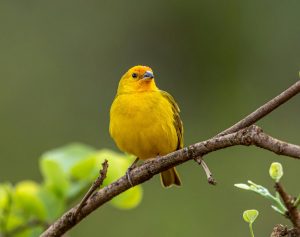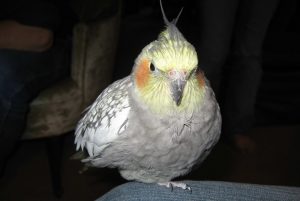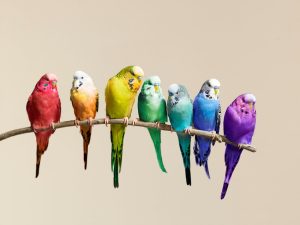The Macaw is one of the world’s most famous pet birds, known for its dazzling beauty and exceptional intelligence. It’s loved not only for its eye-catching colors but also for its energetic personality and impressive communication skills. If you’re considering owning a Macaw, this article from KnowAllAnimals will provide you with useful information on their characteristics, care, and what you need to know about living with these magnificent birds.
Scientific Classification
- Kingdom: Animalia
- Phylum: Chordata
- Class: Aves
- Order: Psittaciformes
- Family: Psittacidae
- Subfamily: Arinae
- Tribe: Arini
1. Overview of the Macaw
Macaws are not only a symbol of nature but also an important part of the culture and life of many indigenous peoples in the regions where they live. The distinctive characteristics of Macaws make them one of the most remarkable parrot species in the world.
1.1. Origin and History
Macaws belong to the family Psittacidae and are native to the tropical forests of Central and South America. Some can also be found in Mexico and the Caribbean. Their ancestors appeared on Earth millions of years ago, and to this day, they still carry the beauty of the wild along with rich biodiversity.
Throughout their development, Macaws have played an important role in maintaining the balance of the tropical forest ecosystem. With their ability to spread seeds through their diet, they contribute to the regeneration of plants in their natural habitat. However, the increasing demand for them as pets has led to a severe decline in their numbers in the wild. Many species are now on the endangered list due to illegal trade and habitat destruction.
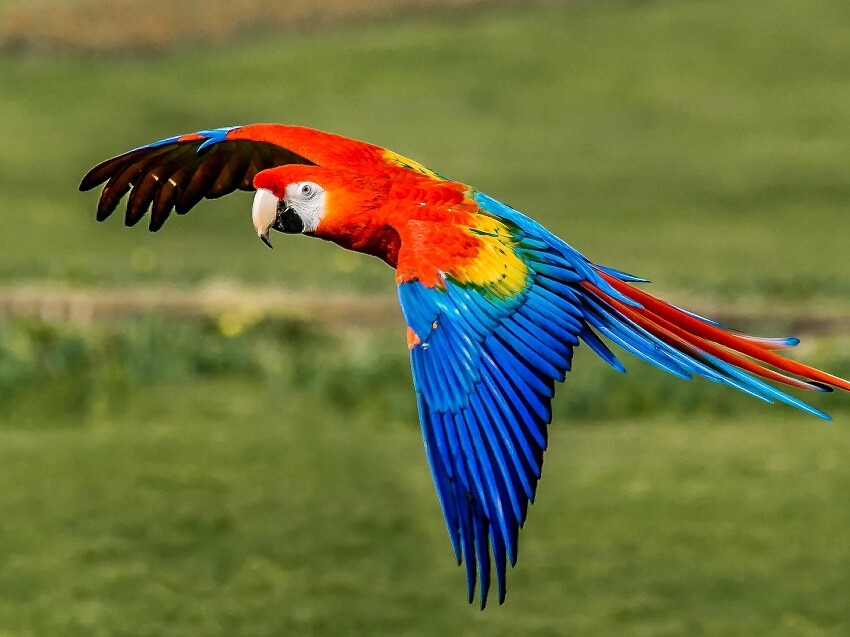
1.2. Colors and Characteristics of the Macaw
One of the biggest attractions of the Macaw is its brilliant plumage. Their colors are very diverse, from red, yellow, and blue to purple, giving them a striking and captivating appearance. This combination of colors also reflects their health and emotional state.
In addition to their colors, Macaws have many unique physical characteristics:
Their beak consists of two parts: the upper and lower beak. The upper beak is longer and curves inward. The lower beak is shorter and tends to press inward.
Macaws have large, round eyes that are black or red, depending on the species.
This species of bird also has an impressive and interesting crest made of soft feathers that stand out on the top of their heads.
The bird’s body is large and long, with a broad chest, a curved back, and a wide abdomen. The neck area, however, is quite short and large, covered by a thick layer of feathers.
Their legs are short, but large and strong, with sharp, firm claws that help them easily balance on branches and in rock crevices.
They can climb trees and branches with great skill.
The most impressive part of the Macaw is the feathers covering its entire body, wings, and tail. The feathers are soft and smooth, with beautiful, vibrant colors.
Depending on the species, they have different colors. The most common are blue, green, and fiery red.
The length of the feathers varies depending on the location. On the wings and tail, the feathers are long, thick, and stiff. The downy feathers on the body, however, are light and soft.
Macaws are generally large. On average, they weigh between 1.2–4 kg (2.6–8.8 lbs). Smaller species, for example, weigh about 1.2–2 kg (2.6–4.4 lbs). Their length is typically from 8.6–100 cm (3.4–39 inches).
1.3. Temperament
Macaws are known for their very energetic and intelligent personality. They are quick learners, not only in their ability to mimic sounds but also in their ability to interact with humans. This makes them fun companions. However, this active personality can also lead to some problems if it’s not managed well.
It can be said that this parrot species is very social and can get bored easily if isolated. They need daily interaction to develop well both physically and mentally. Spending time playing, training, and communicating with them is very important. Otherwise, they can become depressed and exhibit destructive behaviors, such as biting household items or constantly screaming.
In addition, Macaws are very loyal to their owners, and they can form a strong bond with humans. However, this also means they need to be trained and educated from a young age to build good habits and understand boundaries.
1.4. Macaw Breeding Habits
Macaws can breed in many seasons throughout the year, with no fixed breeding season. However, summer, when the weather is very warm, is the most common time for them to reproduce.
This species of bird reproduces sexually through internal fertilization. When it’s the breeding season, the male and female birds seek each other out and build a nest together in a tree trunk. They then mate and lay eggs.
Their nest is usually built sturdily, constructed from straw and small branches. This creates a comfortable, warm space, suitable for the young parrots that will be born later.
The female bird usually lays 4–8 eggs. The eggs are small and off-white. During the time the female incubates the eggs, the father’s duty is to forage for and provide food for the mother bird.
Once the eggs hatch, both parents will take turns finding food for the young birds. Once their feathers and wings are fully grown, the young birds will be able to find their own food and become independent.
The parent birds will then leave to begin a new cycle in their life.
1.5. Macaw Lifespan
The lifespan of a Macaw varies significantly depending on its species. For example, blue and gold macaws will live up to 35 years in the wild. While scarlet and green-winged macaws can have a lifespan of 70 to 75 years. In general, these birds live an average of 60 years in the wild, but some individuals have survived into their 80s and beyond.

2. How Many Types of Macaws Are There?
There are about 19 different species of macaws, and each one has a unique color, size, and set of characteristics. This diversity makes raising a macaw even more interesting, as you can choose a species that fits your preferences and living conditions. Some of the most popular macaw species include:
Blue-and-Yellow Macaw: This is one of the most common macaw species, with a striking blue body and yellow feathers on its wings and tail. They are very friendly and easygoing.
Scarlet Macaw: This species’ plumage is predominantly red, with a mix of blue and yellow on the wings and tail. They are very energetic and love to play.
Green-and-Yellow Macaw: With a vibrant green body combined with bright yellow on its chest and belly, this parrot is particularly eye-catching.
Green-Winged Macaw: This species has a mostly green body with prominent blue wings. It’s one of the most beloved birds in the pet community.
Red-Fronted Macaw: This macaw has a red forehead and a blue body and tail. They are very intelligent and quick learners.
Hyacinth Macaw: This is the largest species of macaw, with a beautiful and rare deep blue coat.
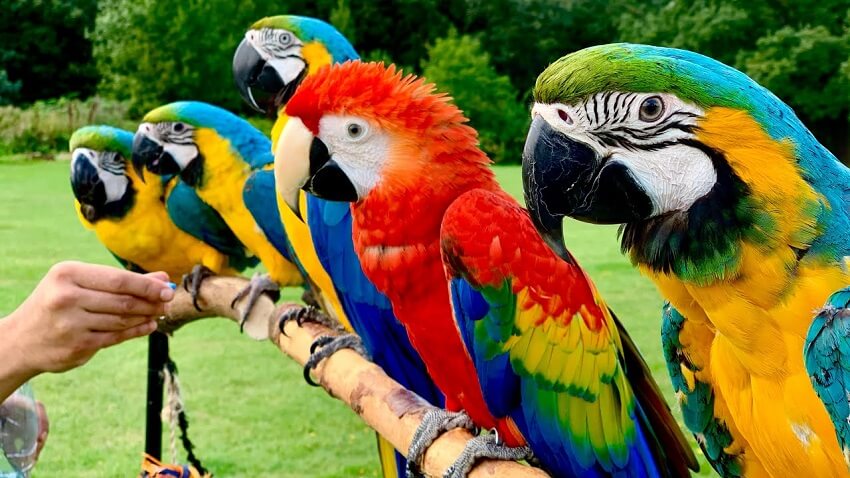
3. Tips for Raising Macaws
Macaws are a popular pet choice for many. Raising this bird species is relatively easy because they adapt well to Vietnam’s climate and their diet is quite simple.
So, how can you best raise a Macaw?
3.1. What Do Macaws Eat?
A Macaw’s diet needs to be not only diverse but also nutritionally balanced. They are an omnivorous bird, which means they can consume both plants and animals, but their diet consists mainly of seeds, fruits, and vegetables.
Seeds: Sunflower seeds, millet, walnuts, and pumpkin seeds are nutritious seeds that macaws love. You should feed them in moderation to prevent obesity.
Fruits: This parrot species loves to eat fruits like bananas, apples, oranges, avocados, mangoes, and watermelon. Fruits not only provide vitamins but also boost their immune system.
Vegetables: Vegetables like carrots, cauliflower, cabbage, and zucchini are also good choices for their diet.
Supplements: In addition to their main diet, you should add specialized parrot food and vitamin and mineral tablets to ensure your macaw gets enough nutrients.
You should wash all fruits and vegetables before feeding them to your bird to prevent bacterial infections. You also need to monitor them to quickly detect any signs of a food allergy or intolerance.
3.2. Macaw Cage
Macaws are typically kept in cages with a durable, compact structure. Cages are designed to be sturdy, made from materials like wood, plastic, or stainless steel, and are both simple and attractive.
The inside of the cage is usually set up to resemble a natural environment, including a system of wooden or stainless steel perches and bowls for food and water.
Metal cages are quite popular today because they have a simple but modern style. They are also clean and easy to sanitize.
A parrot cage should be placed in an area that is well-ventilated, clean, and fresh.
3.3. Macaw Health Care
When you are raising a macaw, you need to pay attention to their health. You should bathe and clean them regularly.
Parrots generally love water and enjoy water dripping down their feathers.
You should remove dirt and dust from their bodies and brush their feathers to get rid of any parasites.
After each bath, you should dry their feathers completely to prevent them from staying wet for too long, which could cause a cold, coughing, or sneezing.
3.4. Exercise
Macaws are very energetic birds, and exercise is an essential part of their daily lives. A lack of exercise can lead to obesity, muscle atrophy, and other health issues.
Provide Toys: Toys not only entertain macaws but also stimulate them to be active. Items like swings, slides, bells, and balls will make them feel excited and always wanting to explore.
Let the Bird Out of Its Cage: Letting your bird fly outside of its cage is a great way for it to get exercise. However, you need to ensure there are no dangers around and always supervise them to prevent accidents.
Training: Training your bird to perform simple exercises like jumping through a hoop, retrieving objects, or following commands will help them improve their agility and flexibility.
3.5. Common Health Issues in Macaws
Macaws can experience some health problems if not cared for properly. Here are some common illnesses that you should be aware of:
Obesity: If a bird eats too much fatty food and doesn’t get enough exercise, it can become obese. Obesity can lead to cardiovascular problems and shorten a bird’s lifespan.
Feather Plucking: This can be a sign of stress, malnutrition, or an unsuitable living environment. Providing a sufficient diet and a comfortable living space will help minimize this behavior.
Digestive Issues: Macaws can have digestive problems if they eat unsanitary or inappropriate food. Ensuring proper hygiene and choosing high-quality food is the best way to prevent this.
If you notice your bird showing any abnormal signs, you should take it to a veterinarian for a timely check-up and treatment.

4. How Much Does a Macaw Cost?
The price of a macaw depends on many factors. Before you decide to buy, you need to research and choose a type that is right for you. A smaller parrot will require less space. If you have the room, you can choose a larger bird. When selecting a macaw, you should choose one that has bright, healthy eyes and full feathers.
The price of a parrot will vary depending on its size, age, origin, color, or feathers. On average, a macaw will cost between $200 and $1,200 per bird. A beautiful and intelligent bird can cost tens of thousands of dollars.
5. FAQs
Are Macaws the biggest parrots?
Of all the parrot species, the Hyacinth Macaw is considered the largest. They can grow up to 100 cm (39 inches) in length and weigh up to 1.7 kg (3.7 lbs), making them one of the most impressive birds.
How many types of Macaws are there?
As mentioned, there are currently about 19 different species of macaws in the world, each with its own unique color, size, and personality. This diversity is one of the reasons why macaws are such a popular pet bird in the bird-keeping community.
Can Macaws live for more than 80 years?
Macaws are known for their long lifespan, which can be anywhere from 50 to 80 years, and some can even live up to 100 years. This requires owners to be prepared for a long-term commitment.
Can Macaws be bred in captivity?
Breeding macaws is not an easy task, but it is entirely possible if you have enough knowledge and experience. This process requires proper care and management to ensure the health of both the parents and the offspring.
Are Macaws strong enough to crack open a coconut?
One of the most notable features of a macaw is the strength of its beak. Some macaw species are strong enough to crack open a coconut, showing their exceptional ability to handle hard foods.
Raising a Macaw is a fun and challenging experience. With their energetic personality, intelligence, and vibrant beauty, a macaw is not only an ideal companion but also an indispensable part of many bird lovers’ lives. However, caring for them requires hard work, patience, and knowledge. We hope the information in this article has given you more insight and better prepared you for raising your macaw.
References: https://en.wikipedia.org/wiki/Macaw

